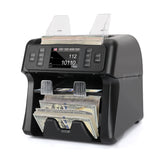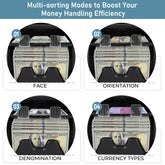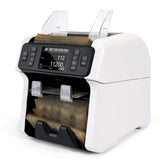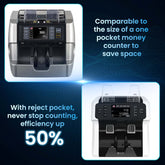How to Train Your Cashiers for Handling Cash?
Training your cashiers to handle cash is more than teaching math skills. They need to serve customers, keep records of transactions, and balance sales at the end of their daily shifts. It’s a tedious and risky job.
If you train and equip them well with the right tools, they can be the most valuable assets of your business. Two key components of success here are the trained staff and high-quality equipment to handle cash efficiently.
Cash is Still the King of Your Business
We have come a long way to move from traditional payment methods to cards and digital wallets. Still, cash remains a popular choice for customers for paying at brick-and-mortar businesses.
Nearly half of the small-value payments under $10 and 42% of payments under $25 were made in cash by consumers. That’s the case for most bustling businesses like restaurants, cafes, and grocery shops.
The number of customers making cash payments in a 12-month rolling period stood at a staggering 61% at brick-and-mortar POS or cash on delivery transactions.

Stat Source: Statista.com
Some businesses see a larger influx of cash than others:
- Large retail chain stores
- Supermarkets, departmental stores, and hypermarkets
- Restaurants, Cafes, and bakeries
- Small retailers like salons, boutiques, and grocery shops
Whichever type of business you run, you’ll need to handle cash. In some cases, you’ll have to deal with piles of currency notes each day. It means you’ll need trained employees to manage banknotes and keep your business safe.
Cash management is a sophisticated job even for experienced cashiers. For inexperienced employees, it will become a daunting task without proper training.
How to Train Your Cashiers for Handling Cash?
Cash handling is more than counting the till. Even if you hire qualified staff with adequate math skills, you’ll need to set them up for success at your business.
Assign Duties
Define the job description during and after hiring employees clearly. It includes communicating duty hours, hardware and software access, reporting duties, and sign-off protocols.
A cashier’s duty will be to serve customers at the counters, handle all types of transactions, balance the sales, prepare daily reports, and hand over the drawer to the supervisor.
Role Segregation
A single person handling cash at any business is a recipe for disaster. Without clear role segregation, you cannot manage employees efficiently.
Therefore, create clear job descriptions, roles, and responsibilities for all employees including cashiers, supervisors, and managers for your business outlet.
Physical Cash Handling
This section should clearly define physical cash handling procedures and protocols. For example, if you allow managers to ask for petty cash from a cashier’s draw and its daily limit?
Some key points here are:
- Only authorized access to cash counter machines, drawers, and POS.
- Issuance of petty cash should be authorized and signed by the supervisor.
- Each cashier’s drawer should observe the volume limits and excess cash should be transferred to the vault or deposited in the bank account.
- A cash transfer to the vault should only occur in security.
- Managers should monitor reports and reconciliation of balances.
Accountability
Some businesses might allow a small amount e.g. $5 in arrears to each cashier’s shift. However, any shortages or overages should be balanced daily and discrepancies must be reported to the supervisors.
Creating a sense of accountability improves the efficiency of all employees including cashiers.
Reconciliation
The final section of training links to the cash reconciliation process. It should include the reconciliation protocols for each shift or day.
Following a strategic approach to training your cashiers will ensure maximum efficiency and security for your business. However, it is an ongoing process and shouldn’t be considered a solitary event.
Best Practices for Cash Handling
Even the most experienced and well-trained employees need to follow the best practices in operations for optimal efficiency. It creates a disciplined approach to operations and improves security.
Keep a Cash Register
You don’t need to keep a manual cash register when you are equipped with a bank-grade cash counting machine. A high-quality bill counter and a sophisticated POS installed should suffice your need to keep an electronic cash register.
It will help you keep an accurate record of cash transactions. Moreover, you can account for discounts, vouchers, and tips in all transactions.
Prepare a Till Count
A till count is a money movement record that helps you identify the number of banknotes and denominations at the end of the day.
Starting and ending a cashier’s shift with a till count ensures accuracy. It helps you in keeping the change for customers, avoiding discrepancies, and easier reconciliation.
Learn Banknote Identifiers and Symbols
There is a slim chance that your cashiers may encounter fake currency notes. It is still a business risk for you and a security risk for your employees.
One way to handle the situation is to train your cashiers for banknote identifiers and symbols. They can learn and practice to detect counterfeit money.
An accurate and efficient way to do that is to invest in a high-quality money counting machine that comes with advanced detection technology to detect “super dollars”.
Assign Custodians of Cash Drawers
Although it’s challenging to assign individual custodians of cash drawers for large entities but you should work to minimize the involved personnel.
Also, make sure to separate duties for the cashiers and managers. A single person shouldn’t be allowed to open and close the register.
Arrange Cash Drops
If you run a busy store outlet or a business with a large cash inflow, you must arrange multiple cash drops daily.
The best practice here is to involve at least two employees with each transfer to the vault. Make sure the cashier doesn’t have access to the vault lock combinations alone.
Using a Reliable Cash Counting Machine - Your Cashier’s Big Advantage
A cashier’s job is tedious and time-consuming. They must serve customers, promote your offers, and keep the records accurate at the counters.
What if you find cashier’s drawers overflowing throughout the day?
Turn this risky situation into your cashier’s big advantage by arranging a reliable cash counting machine that does the heavy lifting for them.
Your well-trained cashiers and our high-quality cash counting machines will provide a solution to streamline your cash management process with accuracy, efficiency, and enhanced security.








